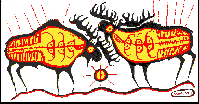Biography
| Norval Morrisseau
is founder of a Canadian-originated school of art called Woodland or
sometimes Legend or Medicine painting. His work is influential on a
group of younger Ojibwe and Cree artists, such as Blake Debassige, Tom
Chee Chee, Leland Bell. He has had many exhibits in Canada and Europe
(especially France), but is not well known (except to northern Indians)
in the U.S. This may change; recently Morrisseau had an exhibit and
well-attended showing at the McLeod-Maslak Canadian Art Gallery in Santa
Fe, the heart of what's trendy in U.S. Indian art.
Grandfather Potan was a Midewinini and Jissakan -- shaking tent seer. Norval learned stories, myths, spiritual things from his grandfather while growing up. He gained only a 4th-grade education at the Indian boarding school in Ft. William (now Thunder Bay). Back on the reserve he explored old sites and canoe routes, paying particular attention to petroglyphs or rock art. Whn he tried to paint his thoughts, dreams and visions, older people told him not to. When he was 19, he got tuberculosis -- a common and often fatal disease among Indian people. He was sent to a long-trm care hospital at Ft. William, where one of the doctors encouraged him to paint. At the hospital, he met Harriet Kakegamic, Cree. They were married and had 6 children before the marriage broke up. Still at the hospital, Morrisseau had a series of dreams and visions that he said were calling him to be a shaman-artist. "My paintings are icons, that is to say they are images which help focus on spiritual powers, generated by traditional belief and wisdom." Morrisseau's paintings for the first years were what's been called "x-ray vision". The artist paints what's felt or perceived inside animals (including pople) These represent a kind of spirit-guts: sources of powers.
Below is an early painting in this style, "Two Bulls Fighting,". The Glenbow Museum owns it. The x-ray anatomy of each bull moose is shown. Here is the x-ray anatomy, the spirit power lines radiating from the spines of the animals, and the ball of radiant spirit power that appears between them which may represent the Migiis -- explained later). These -- in greater complexity -- are features adopted by most painters of the Woodland School. These features can all be found -- not with this artistic elegance -- on birchbark scrolls of Midewiwin rites, and song mnemonics. Some features of this kind of are roughly suggested in the rock petroglyphs, found all over North America, but in certain styles, over the Canadian Shield and Great Lakes woodlands, though these have received almost no attention in comparison with petroglyphs of the Southwest.
This led to jealousy among tribal members who criticized Morrisseau for revealing the tribe's legends and beliefs in the paintings. (Since the paintings speak to the emotions but not in words, they may be based on legends and myths, but don't actually narrate anything.) Probably the cricitism stemmed mostly from Morrisseau's book Legends of my People, the Great Ojibway,, edited by Dewdeney, Toronto, Ryerson Press, 1965, (long out of print). Morrisseau defended himself, saying he wanted to restore cultural pride to the largely catholicized people. Indeed, the visual language he developed has spoken powerfully to artistically inclined Woodland Indians all over the north. |
|---|
http://kstrom.net/isk/art/morriss/morbio2.html
All text and graphics at this site copyright 1995, 1996,
1997 by Paula Giese
This site hasn't been updated since 1997 so unless you convince me the site is going to stay up and safe I'm keeping this valuable up and running and it ha nothing to do with financial gain of any kind.

 Morrisseau
traded paintings for art supplies and food for his growing fzamily. He
lived in poverty with his family on the reserve. In the early 1950's he
met Selwyn Dewdeney, a former missionary who was studying rock art of
the Canadian shield. He guided Dwdeney, who later edited Morrisseau's
book of legends. In 1962, he met a Toronto artist-gallery owner Jack
Pollock, who was teaching painting in northern Ontario. Pollock was so
impressed with Morrisseau's paintings that he put on a solo exhibition
of Morrisseau's work at his Toronto gallery. The show was an astonishing
success; all the paintings sold out in one day. (This is very unusual).
Morrisseau
traded paintings for art supplies and food for his growing fzamily. He
lived in poverty with his family on the reserve. In the early 1950's he
met Selwyn Dewdeney, a former missionary who was studying rock art of
the Canadian shield. He guided Dwdeney, who later edited Morrisseau's
book of legends. In 1962, he met a Toronto artist-gallery owner Jack
Pollock, who was teaching painting in northern Ontario. Pollock was so
impressed with Morrisseau's paintings that he put on a solo exhibition
of Morrisseau's work at his Toronto gallery. The show was an astonishing
success; all the paintings sold out in one day. (This is very unusual).